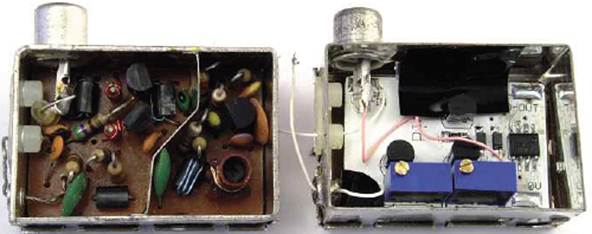We manage to get hotd of a brand new,
unopened Sinclair ZX81 kit from 1981. Now he readies his soldering iron to see
how the computer building process has changed over the last three decades...

The
diagram on the back of the box shows how to hook up the computer, but says
nothing about the amount of soldering involved in building it.
The fact that you’re reading this magazine
means that you’re more | than likely familiar with the concept of building your
own PC. Putting together your own computer wasn’t always as easy as the
standardised jigsaw puzzle we have now though. To give you an idea of just what
it meant to be a system builder back in the bad old days, we’re going to take
you on a .trip down memory lane to the golden era of micro computing: the
1980s.
For the benefit of younger readers, the
1980s was a magical time. Despite a little war and some unpopular decisions by
the first female prime minister, Margaret Thatcher, the 1980s is remembered by
most geeks as being the birth of what you may recognise as the computing era.
Microcomputers - simple, 8-bit machines with very little memory – were taking
the world by storm, and Britain was at the forefront. At the start of
the decade, Sinclair Computers - founded from the ashes of Clive Sinclair’s
Sinclair Radionics - would offer the world’s first home computer for under
£100: the ZX80.
Following the success of the ZX80, and the
launch of the Acorn Atom from Sinclair’s bitter rival (and former employee)
Chris Curry, Sinclair demanded more: a bug-fixed system that could be sold for
even less money. The result was the ZX81.
Launched, as the name suggests, in 1981,
the ZX81 cost £69.95 by mail order directly from Sinclair. If you were a
cheapskate, or of a curious mindset, however, you could also opt to buy the
machine in kit form for just £49.95 - the equivalent of around £170 now; and
this was at a time when rival machines cost closer to the £300 mark.
For your cash, you acquired a machine based
around the Zilog Z80 processor – or a compatible chip from NEC – running at
3.5MHz, with a whopping 1KB of RAM and a copy of Sinclair BASIC held in an 8KB
ROM (read-only memory).

The
black ICs are roughly the same parts as those of a modern computer, with a CPU
and a pair of RAM chips.
It’s easy to scoff at the now-meagre
specifications, but to get a real sense of how times have changed there’s only
one thing for it: to get the DeLorean up to 88mphand get our hands on a
kit-form ZX81 for some microcomputer building action.
After waiting the required 28 days for
delivery - the postal service was different back then, and Sinclair wasn’t
above taking peoples’ money for devices that didn’t quite exist - we returned
to 2012 with our very own ZX81 kit. In the box we found a plastic casing
finished in futuristic black, along with a surprisingly compact, printed
circuitboard, a power supply – to which we’ll have to attach our own plug later
- some leads for a tape recorder, an RF modulator, a keyboard, and several bags
of components.

The
ZX81 includes an RF (aerial socket) modulator (left) as standard. However,
we’re going to do a little modding, and replace it with a unit that's capable
of outputting a composite signal for current TVs (right).
Looking in the bags, some components are
more obviously recognisable than others. A bag of black ICs, for example, are
roughly the same part as a modern computer has to day: an NEC D780C-1 is the
CPU, a pin-compatible Zilog Z80 clone, while a pair of 512-byte 2114 RAM
chipstake the place of DIMMs.
Less recognisable are the Ferranti
Uncommitted LogicArray (ULA) and the ROM, marked 'Sinclair Research’. The
former is the secret of Sinclair’s low-cost success: the ULA is a semi-custom
chip which takes on the roles of 12 of the chips found in the original ZX80,
reducing the complexity and cost dramatically. It’s almost like the Northbridge
and Southbridge of a modern PC, although it also has shades of a system-on-chip
(SoC) about it if you ignore the lack of on-board CPU.
The ROM chip is the ZX81 ’sonly on-board
storage. Permanently burned into the chip is the bootloader for the device -
the equivalent to a BIOS or EFI in a modern PC-along with a copy of the
ZX81’soperating system: Sinclair BASIC.
Other components are less obvious: the
transparent bags, packed dutifully by Sinclair assembly-line workers anxious
not to become another unemployment statistic, contain an assortment of
resistors, diodes, capacitors and transistors - and not a surface-mount
component in sight. Each one needs to be attached to the PCB by hand and in the
right location - meaning that we’re going to have to add a soldering iron to
our PC-building toolkit for the first time in years. After identifying all of
the components and matching them to the provided assembly guide, it’s time to
start the build.